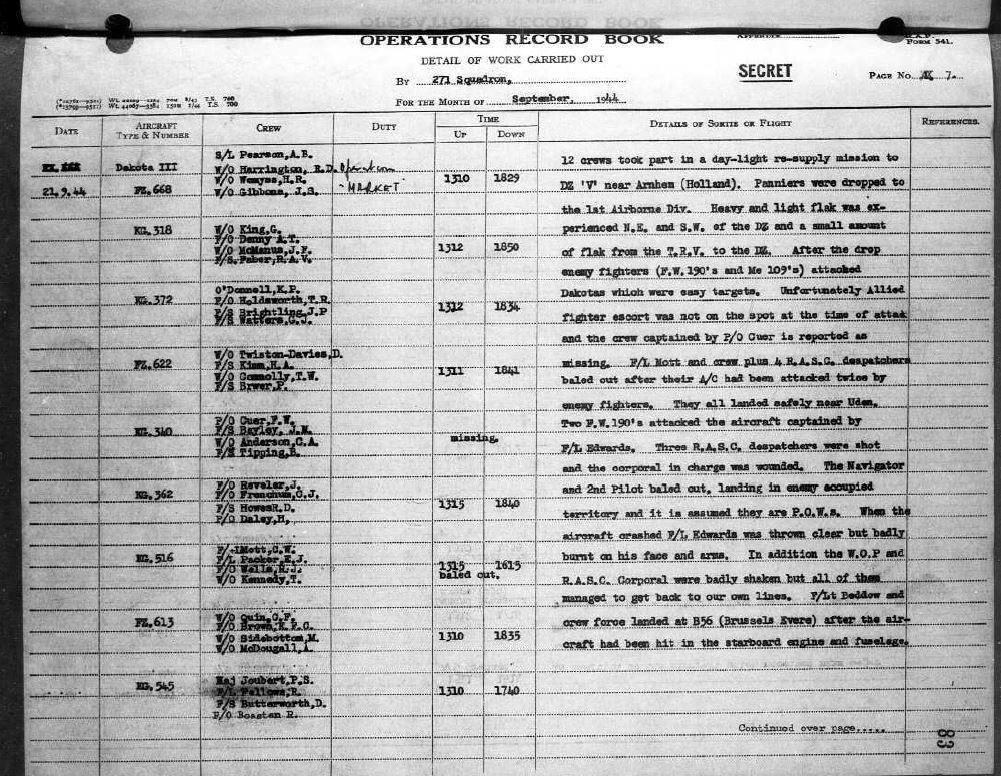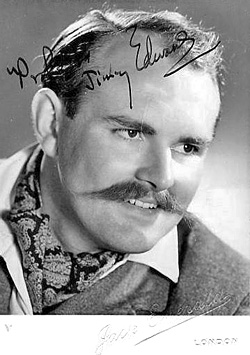 During the fifth day of Operation Market Garden,12 crews from the 271 Squadron took part in day light resupply mission to the DZ 'V' near Arnhem. Our aircraft, FZ668 was part of this mission. On the ground, combats are raging between allied troops and German forces. Earlier during the day, a supply attempt by RAF Stirling of 38 group was disrupted by the only Luftwaffe fighter interception during the operation. Several Stirling were shot down and message was tried without success to be sent to UK to warm about the enemy presence. Allied escort was not available, and Dakota were under attack from FW190 and Me109. Kg340 piloted by the P / O Cuer is shot down, 5 of the 8 crew members managed to leave the aircraft before its crash. KG516 is also a victim of enemy aircraft, its crew parachutes in time. FZ615 is hit but manages to land in Brussels. KG444 is shot down too. His pilot was the F/L James Edwards, DFC who will become after the war a famous actor and radio host. One week later, with the help of the french resistance, he will be able to fly back to UK and gave the statement to the MI9, the intelligence service responsible to support allied airmen shot down over occupied Europe.
During the fifth day of Operation Market Garden,12 crews from the 271 Squadron took part in day light resupply mission to the DZ 'V' near Arnhem. Our aircraft, FZ668 was part of this mission. On the ground, combats are raging between allied troops and German forces. Earlier during the day, a supply attempt by RAF Stirling of 38 group was disrupted by the only Luftwaffe fighter interception during the operation. Several Stirling were shot down and message was tried without success to be sent to UK to warm about the enemy presence. Allied escort was not available, and Dakota were under attack from FW190 and Me109. Kg340 piloted by the P / O Cuer is shot down, 5 of the 8 crew members managed to leave the aircraft before its crash. KG516 is also a victim of enemy aircraft, its crew parachutes in time. FZ615 is hit but manages to land in Brussels. KG444 is shot down too. His pilot was the F/L James Edwards, DFC who will become after the war a famous actor and radio host. One week later, with the help of the french resistance, he will be able to fly back to UK and gave the statement to the MI9, the intelligence service responsible to support allied airmen shot down over occupied Europe.
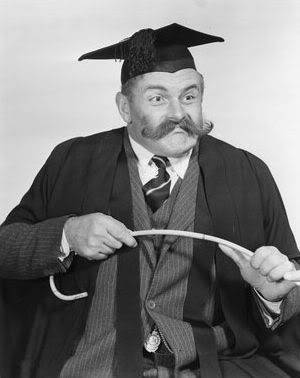
Well known after the war as comedian and writer, "Professor" James Edwards serverd with No 271 Squadron and earned a Distinguished Flying Cross.He used is trademark huge handlebar moustache to disguise facial injuries received during the crash of his Dakota KG444.
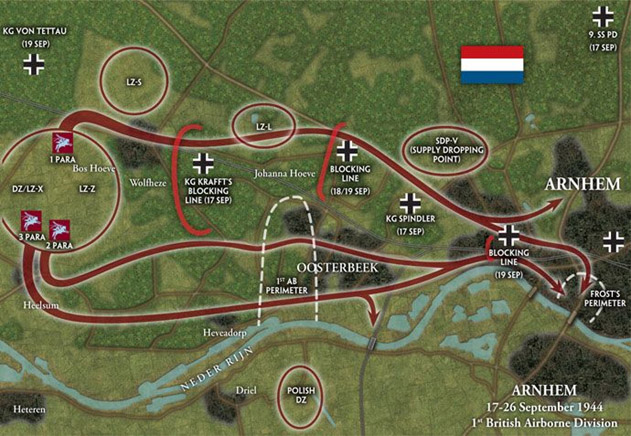
Location of the DZ "V"
271 Squadron log - 21/09/1944
Statement from F/Lt Edwards 271 Squadron on experience on D+4 days 21st September, Operation Market.
We had successfully dropped our panniers on the D.Z. area and turned for home climbing to 7000ft, and the first intimation I had that anything was wrong was when I saw about six fighters which I could not identify as Allied, away on my port side. Before I could make sure of their identity we were attacked from behind, strikes being obtained on fuselage and wings; tracer also appeared bursting ahead of the aircraft and under the impression that it might be Flak I took suitable evasive action. After a moment, however, I saw, out of the corner of my eye, what was unmistakably a FW190 commencing an attack from the port side. His cannon fire was passing across ahead of the aircraft, so I pulled back the stick and kicked hard on left rudder and avoided attack and dived for cloud. I then warned the crew of the presence of fighters and the W/Op sgt Randall took up station in the astrodome.
We reached cloud before a further attack materialized but this cover did not last long and as soon as we broke from cloud another attack came from Eastern resulting in several strikes. The next few minutes were spent in dodging in and out of what cloud cover was available and during this time were subjected to three more attacks all of which registered hits on our aircraft. The navigator gave me a course to steer but the compass just then was so badly upset that I was unable to follow the course given and the frantic dodging about in the past few minutes made it impossible for my co-pilot to give me a pinpoint.
Avialogs is restoring the Dakota FZ668, which operated with the RAF 271 Squadron during the second world war.
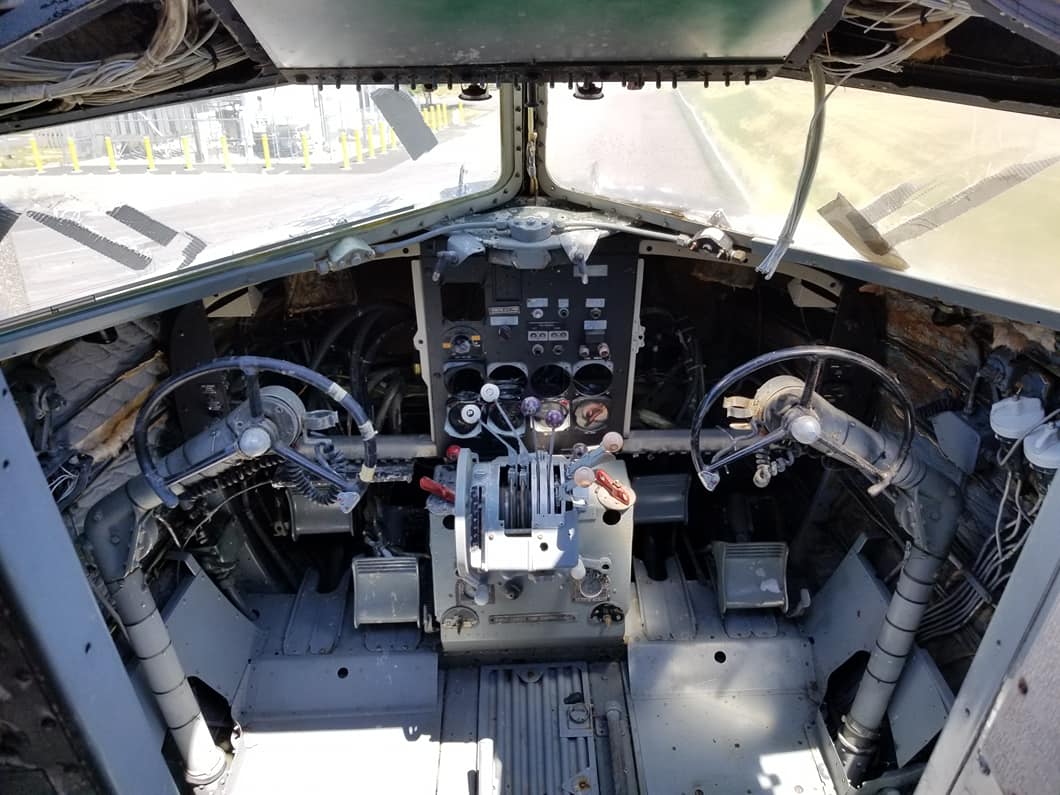
This historic aircraft which took part of major missions and combats can be restored to her former glory with your help.
Yes! I want to help to restore the Dakota FZ668
The FW190 was obviously taking his own time in making his attacks and was always above and astern so that it was extremely difficult for the W/op in the astrodome to anticipate the exact moment of attack. I had full revs and throttle up to now and had found in my preliminary dive for cloud that the elevator trim was o/s. During the sixth and last attack I lost aileron 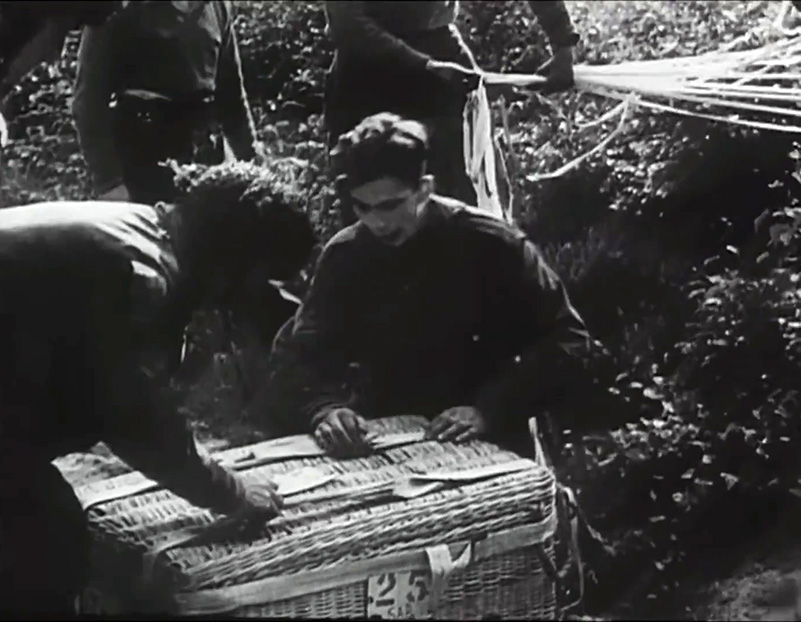 control and so gave the order to bale out. The co-pilot and navigator jumped and at that time I was under the impression that the rest of the crew and despatchers had also gone but later I found this was not the case. After barely a minute I looked round and saw three despatchers sitting by the cabin door and asked why they hadn’t jumped and one of them said they could not, so I concluded they must have been wounded, and I then decided to stay in the aircraft and crash land, but almost immediately both propellers went into ‘fully fine ‘and I throttled back in preparation for crashing.
control and so gave the order to bale out. The co-pilot and navigator jumped and at that time I was under the impression that the rest of the crew and despatchers had also gone but later I found this was not the case. After barely a minute I looked round and saw three despatchers sitting by the cabin door and asked why they hadn’t jumped and one of them said they could not, so I concluded they must have been wounded, and I then decided to stay in the aircraft and crash land, but almost immediately both propellers went into ‘fully fine ‘and I throttled back in preparation for crashing.
We were approximately at 6000ft when the aircraft went into a steep dive I found that somehow I had regained partial aileron control and at about 100ft from the ground I held off to reduce speed. We were passing over a village with numerous haystacks and I shouted out “Standby for crash landing “although I’m pretty sure no one heard me. I selected ‘flaps down’ but whether I got any flap I shall never know. I remember frantically trying to strap myself with one hand but found this impossible. At about 50ft up I opened the escape hatch and the draught caused a great rush of flame from the back of the cabin. A despatcher came lurching forward crying “Christ the flame is coming right in”, This was the first idea I had that the aircraft was on fire (I learned later that fire had been raging for some minutes) and the cabin was now well alight, so I stood up and put my head out through the escape hatch and rested it on my forearm, my other hand still being on the control column. I looked along the port wing and had a quick glimpse of it being smashed against numbers of small trees and then the aircraft hit the ground. With the impact I was thrown half out of the hatch and was enveloped by a sheet of flame. I hung on because I feared being thrown completely out in the path of the aircraft which was still sliding along the ground. Suddenly the nose dipped, and the tail came up almost vertical whence I fell to the ground in front of the starboard engine. 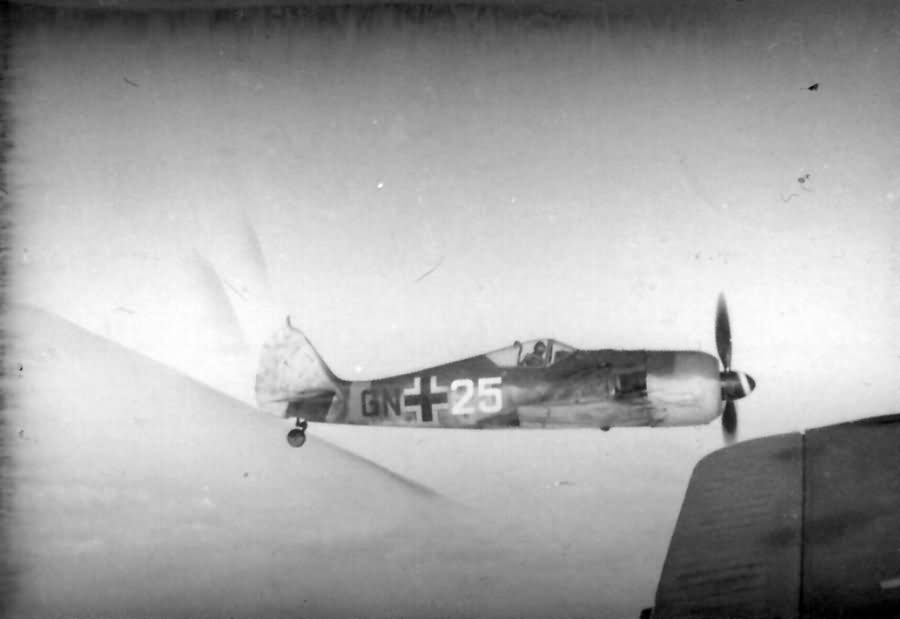 I picked myself up and ran away from the machine which was now a mass of flames. The aircraft had crashed in a small clearing surrounded by trees and as I ran towards these I saw the Fw190 doing a steep turn at about 100ft. directly above. I also realized now that the W/op and one despatcher had crashed with me and had get clear of the aircraft and sensing that the FW might attack us again I warned the other two to take cover in the trees. I barely had time to get to the trees myself when the FW. Returned and commenced to strafe us. I only heard 3 shells and assumed that the enemy had run out of ammunition, which was a good thing as I was still wearing my Mae West which made me too good a target for my peace of mind. We all got together and crawled into a belt of larger trees and sat down to consider the situation. I buried my Mae West and found that Randall was unhurt whilst the despatcher was suffering from flesh wounds but could easily walk. I was burned in face and arm but otherwise felt fit enough for travel. We took the compass from our escape kits and decided to go south but had no sooner commenced to crawl away from our shelter when we heard voices in the vicinity.
I picked myself up and ran away from the machine which was now a mass of flames. The aircraft had crashed in a small clearing surrounded by trees and as I ran towards these I saw the Fw190 doing a steep turn at about 100ft. directly above. I also realized now that the W/op and one despatcher had crashed with me and had get clear of the aircraft and sensing that the FW might attack us again I warned the other two to take cover in the trees. I barely had time to get to the trees myself when the FW. Returned and commenced to strafe us. I only heard 3 shells and assumed that the enemy had run out of ammunition, which was a good thing as I was still wearing my Mae West which made me too good a target for my peace of mind. We all got together and crawled into a belt of larger trees and sat down to consider the situation. I buried my Mae West and found that Randall was unhurt whilst the despatcher was suffering from flesh wounds but could easily walk. I was burned in face and arm but otherwise felt fit enough for travel. We took the compass from our escape kits and decided to go south but had no sooner commenced to crawl away from our shelter when we heard voices in the vicinity.
Through the trees we saw a man and a woman and for some reason it occurred to me that it might be a German that the woman was directing to the aircraft but as we realized that they knew we were there and that if an enemy he would probably spray our hiding place with bullets we decided to go out and take a chance. To our relief we found that he was a civilian. My attempt at establishing friendly relations were nearly doomed to failure I asked where the Bosche were and the woman apparently thinking I meant who was the Boss waved towards the man and said “The Bosche” with the result that I was about to let him have it from my pistol. However, he came towards us then having a group of young inquisitive sightseers and asked us to follow him. With the aid of our language cards we ascertained that no Germans were nearby although they could not tell us where we could contact the British. We went on through the woods for about 20 minutes and at each small clearing our guide halted and made sure there was no one about and then we all dashed across at high speed. Finally, we were settled in the corner of a wood and the guide indicated he would fetch bandages and food and then left us. Later he and his wife returned with food and drink and dressed our wounds. Soon afterward three young men joined us, one of whom produced a white silk handkerchief made from parachute silk bearing the letters A.M. This he waved in from of us as a guarantee of good faith and gave us to understand he would help us as he had helped other British airmen in the past. They them relieved us of our pistols which they seemed to think they would soon to be able to put a much better use then we could. Just before darkness fell a doctor arrived who fortunately spoke English and I was able to converse with him to some extent. We were then led away to a house where the doctor redressed our wounds and we were given coffee. Here we were told that the nearest British troops were at Grave and it was decided we should move on the first stage of our journey on the back of an old cart horse but seeing the anxiety in my face they explained there would also be a cart. After the doctor left a Roman Catholic Priest appeared who spoke moderately good English and with the aid of maps from our purses he showed us the we should go to Grave. We apparently were then at St Antonis.
We then asked them to accept some money in return for their kindness, but this was indignantly refused but at last we persuaded them to accept some toward the expenses of the organization. The padre asked me to write down his name and address so that I could write to him after the war I pointed out the folly of this in view of possible recapture by the enemy who would be sure to deal with him in no uncertain manner. I remembered the Intelligence Officer telling us the results of certain evaders who kept the names and addresses of helpers when in France who were eventually caught with tragic results to the helpers. We later got word that the other two members of the crew were in German hands some 15km away. We were eventually loaded into a 2-wheeled horse buggy (a most unsafe contraption) and all along the route there were men at intervals of about a mile who would suddenly loom up out of the darkness and tell us that the next stretch was clear.
We were most impressed by the efficiency with which the whole affair was handled. We arrived at a farm and entered the kitchen where we sat talking for some time until my W/Op fell asleep over the table. We were then taken to bed where we slept until 6 a.m. At 8 a.m. a large car drove up driven on gas generator principle and we all got in, incidentally whilst waiting for the car several people came in at intervals to inform us the road was clear. We went into Grave with two men on the front mudguard and one on each step quite a triumphal procession and were taken to a dressing station. From there we were taken to Driest where I stayed for three days, before going to Brussels where I remained two days, until I was finally picked up by aircraft and brought back to Down Ampney on the 27th September.

